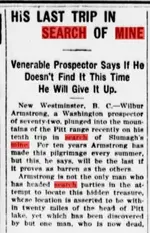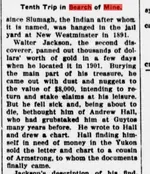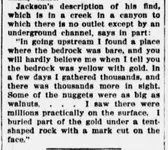Gypsy Heart
Gold Member
- #1
Thread Owner
The legend of the Lost Creek Mine began in the late 1800’s and is a colorful part of the history of Pitt River and the people who lived near there at that time. The story of the mine tells of a mysterious gold mine allegedly located in the Pitt Range, 35 km northeast of Vancouver. It’s said that in the late 1880’s, a native Canadian from the Silver Creek Reserve named Slumach showed up in New Westminster with a sack of gold nuggets.
He would allegedly drink most of it and during his many visits to the town people would try to get him to spill the beans about where he got his gold. Once in a while people would try and follow him but they never got very far as Slumach was known to be very adept at hiding his trail in the bush surrounding Pitt Lake.
He also is said to have taken local women when he returned to the woods, and they were never seen again. In 1890 Slumach shot and killed a metis man, Louis Boulier, also known as Louis Bee, at Lillooet Slough near the Pitt River. Newspaper accounts of the day report of Slumach’s subsequent escape into the bush and the search to bring him to justice. Eventually he showed up, half starved and in bad shape and he was tried, found guilty and hanged in 1891 in New Westminster, never having had the chance to reveal the source of his gold.
After Slumach’s death various adventurers began to search for the gold mine in the mountains beyond Pitt Lake. Some people didn’t believe he had a secret stash, and others thought that he’d stolen the gold. Whatever story they believed, no one had any success and a few people even died in their quest for the gold.
Over the next ten years the search for Slumach’s gold petered out, although the mystery remained and the story changed as more people talked about it. Every once in a while a stranger would show up in New Westminster to try and solve the mystery of the gold.
One, a man known as W. Jackson, set out for Pitt Lake after listening to the local tales. Three months later he emerged from the bush and allegedly dragged himself and a large sack which he wouldn’t show anyone back to New Westminster. He caught a steamer for San Francisco. Three years later he died, never having returned to BC to search for the gold. However, before he died he is said to have written to a man named Hill who had lent him money for different prospecting outings. In his letter Jackson revealed that in 2 months of exploring he had found what he thought were promising locations in Pitt River country but found nothing concrete.
He was just about to give up and come home when he spotted a creek from high up on a ridge. The creek intrigued him because the water was almost white. He went upstream always and found the bedrock yellow with gold. He claimed that the nuggets he found were as big as walnuts and found so many he couldn’t pack them all out. In the letter he revealed that he buried part of the gold at the foot of a large tent-shaped rock facing the creek, and advised Hill that there was a mark cut into the rock.
It took Jackson 3 days to hike out to Pitt Lake, but he then became ill and had to rest for several days. He realized he’d never be able to return for the gold but knew nobody else could find it as it was too well hidden.
After Jackson died, Hill went looking for the gold but soon decided it wasn’t worth the forbidding terrain and gave up.
Over the next two decades others may have searched for the gold without success. Then in the mid 1920’s, Robert A. “Volcanic” Brown, also known as “Doc”, a 75 year old man with an adventurous past, arrived to search for the lost gold. Brown grew up on his family’s farm in New Brunswick, and later worked on fishing boats, trapped with the native Canadians and felled trees. He discovered the Sunset Mine on Copper Mountain in the Similkameen.
In 1890 he sold his interests and continued his adventurous life. In 1924 he was living in Grand Forks and needed a more adventurous life, so he moved to the coast and began searching for gold in the Pitt Lake region. Apparently he had in his possession a copy of the letter Jackson wrote to Hill years before, which he’d gotten from another treasure seeker, and decided to try his luck.
In June 1926 Volcanic Brown traveled up Pitt Lake, visited the Dominion fish hatchery at the township of Alvin, and headed up Seven Mile Creek. He hadn’t reappeared by October so a trapper and a constable with the provincial police headed up a search party to bring him out. They found him in a cabin about 20 miles from Pitt Lake. He had cut off his own toe after frostbite and gangrene had turned them black. In 1931 at 83 years old he again went off into the mountains around Pitt Lake and this time he never came out. His body was never located, although in the fall of 1931 his last camp at the back of Stave Glacier was found, along with, among other things, a jar of gold nuggets that contained quartz.
Some disbelievers think that the entire story of Slumach’s gold was made up , and that the letter from Jackson to Hill was a fake. In the 1950’s local newspapers sent reporters out to look into the matter, and even in the 1970’s several people still took up the search for gold. To this day nobody is sure if the mine and its cache of gold really exists, or if it’s just a fantastic legend that has endured for over 100 years. It’s a story that has fascinated generations of gold seekers and is not likely to disappear as long as people have dreams of finding Slumach’s Lost Mine and its untold treasure.
http://www.pittriverlodge.com/gold.html
He would allegedly drink most of it and during his many visits to the town people would try to get him to spill the beans about where he got his gold. Once in a while people would try and follow him but they never got very far as Slumach was known to be very adept at hiding his trail in the bush surrounding Pitt Lake.
He also is said to have taken local women when he returned to the woods, and they were never seen again. In 1890 Slumach shot and killed a metis man, Louis Boulier, also known as Louis Bee, at Lillooet Slough near the Pitt River. Newspaper accounts of the day report of Slumach’s subsequent escape into the bush and the search to bring him to justice. Eventually he showed up, half starved and in bad shape and he was tried, found guilty and hanged in 1891 in New Westminster, never having had the chance to reveal the source of his gold.
After Slumach’s death various adventurers began to search for the gold mine in the mountains beyond Pitt Lake. Some people didn’t believe he had a secret stash, and others thought that he’d stolen the gold. Whatever story they believed, no one had any success and a few people even died in their quest for the gold.
Over the next ten years the search for Slumach’s gold petered out, although the mystery remained and the story changed as more people talked about it. Every once in a while a stranger would show up in New Westminster to try and solve the mystery of the gold.
One, a man known as W. Jackson, set out for Pitt Lake after listening to the local tales. Three months later he emerged from the bush and allegedly dragged himself and a large sack which he wouldn’t show anyone back to New Westminster. He caught a steamer for San Francisco. Three years later he died, never having returned to BC to search for the gold. However, before he died he is said to have written to a man named Hill who had lent him money for different prospecting outings. In his letter Jackson revealed that in 2 months of exploring he had found what he thought were promising locations in Pitt River country but found nothing concrete.
He was just about to give up and come home when he spotted a creek from high up on a ridge. The creek intrigued him because the water was almost white. He went upstream always and found the bedrock yellow with gold. He claimed that the nuggets he found were as big as walnuts and found so many he couldn’t pack them all out. In the letter he revealed that he buried part of the gold at the foot of a large tent-shaped rock facing the creek, and advised Hill that there was a mark cut into the rock.
It took Jackson 3 days to hike out to Pitt Lake, but he then became ill and had to rest for several days. He realized he’d never be able to return for the gold but knew nobody else could find it as it was too well hidden.
After Jackson died, Hill went looking for the gold but soon decided it wasn’t worth the forbidding terrain and gave up.
Over the next two decades others may have searched for the gold without success. Then in the mid 1920’s, Robert A. “Volcanic” Brown, also known as “Doc”, a 75 year old man with an adventurous past, arrived to search for the lost gold. Brown grew up on his family’s farm in New Brunswick, and later worked on fishing boats, trapped with the native Canadians and felled trees. He discovered the Sunset Mine on Copper Mountain in the Similkameen.
In 1890 he sold his interests and continued his adventurous life. In 1924 he was living in Grand Forks and needed a more adventurous life, so he moved to the coast and began searching for gold in the Pitt Lake region. Apparently he had in his possession a copy of the letter Jackson wrote to Hill years before, which he’d gotten from another treasure seeker, and decided to try his luck.
In June 1926 Volcanic Brown traveled up Pitt Lake, visited the Dominion fish hatchery at the township of Alvin, and headed up Seven Mile Creek. He hadn’t reappeared by October so a trapper and a constable with the provincial police headed up a search party to bring him out. They found him in a cabin about 20 miles from Pitt Lake. He had cut off his own toe after frostbite and gangrene had turned them black. In 1931 at 83 years old he again went off into the mountains around Pitt Lake and this time he never came out. His body was never located, although in the fall of 1931 his last camp at the back of Stave Glacier was found, along with, among other things, a jar of gold nuggets that contained quartz.
Some disbelievers think that the entire story of Slumach’s gold was made up , and that the letter from Jackson to Hill was a fake. In the 1950’s local newspapers sent reporters out to look into the matter, and even in the 1970’s several people still took up the search for gold. To this day nobody is sure if the mine and its cache of gold really exists, or if it’s just a fantastic legend that has endured for over 100 years. It’s a story that has fascinated generations of gold seekers and is not likely to disappear as long as people have dreams of finding Slumach’s Lost Mine and its untold treasure.
http://www.pittriverlodge.com/gold.html









